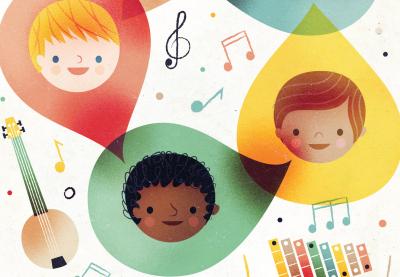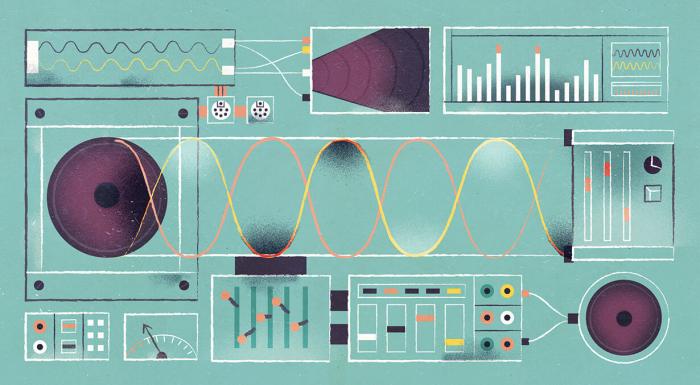Teachers don’t typically encourage students to bring iPods to school, but when a girl in Ken Giles’s class brought him “One Tribe,” a song by the Black Eyed Peas, he was thrilled. Giles, a music teacher in Washington, D.C., uses protest music to illustrate the connections among culture, art, history and social movements and to help his students understand how music can effect social change. Kids have access to an almost infinite number of songs, but this student saw through the clutter, says Giles. “She figured out that, ‘This modern song is like the historical songs he’s been teaching us.’”
Protest songs are part of our cultural consciousness—and a powerful tool in the classroom. Just as music has brought together members of different socioeconomic groups, races and religious convictions into cooperative social movements, protest songs can serve as a versatile teaching resource, culturally relevant to students of diverse backgrounds.
“Everyone has some musical interest,” says Dr. Christopher Andrew Brkich, author of the article “Music as a Weapon: Using Popular Culture to Combat Social Injustice.” That interest is a tool that can be used to hook students and to convey powerful messages that they might miss in traditional texts.
Protest songs allow people to bond on an intellectual level as well as on a deeper, subconscious level reached through shared experience, says William G. Roy, author of Reds, Whites and Blues: Social Movements, Folk Music, and Race in the United States. That shared experience goes beyond listening.
When students are given the opportunity to engage with protest music by singing, the learning experience is enriched. “Music is a very social thing,” says Brkich. “If you’ve ever been to a musical concert, the entire audience sings along with the artist who’s up on the stage. The same thing happens in class.”
Giles agrees that there is greater power in making music than in simply listening to it. “I really do wish people would sing and play instruments,” he says. “When civil rights activists would go out on a demonstration and sing ‘we shall not be moved,’ everyone in the line was singing.”
“It couldn’t but cement the learning experience more strongly,” says Brkich. “The whole class gets engaged in the learning experience.”
As important as the music experience is, it is even more essential that students connect to a song. Students are more likely to participate in class if they can relate to the subject matter. For a teacher, this may mean working with contemporary music, or illuminating the circumstances in which an old song was originally sung. “Try to tell the story that surrounds the song,” Giles advises. “Who were [the singers]? What were they doing? What did they think?”
Civil Rights Protest Songs
If You Miss Me at the Back of the Bus
If you miss me at the back of the bus,
and you can’t find me nowhere,
come on up to the front of the bus.
I’ll be sittin’ right there.
I’ll be sittin’ right there.
I’ll be sittin’ right there.
Come on up to the front of the bus.
I’ll be sittin’ right there.
© 1963 Figs D. Music (BMI) on behalf of itself and Sanga Music (BMI) care of The Bicycle
Music Company
Strange Fruit
Southern trees bear a strange fruit,
Blood on the leaves and blood
at the root,
Black bodies swinging in the Southern breeze,
Strange fruit hanging from the
poplar trees.
—Music and lyrics by Abel Meeropol
Copyright © 1939 (Renewed) by Music Sales Corporation (ASCAP). All Rights for the United States controlled by Music Sales Corporation (ASCAP).
International Copyright Secured. All Rights Reserved. Reprinted by Permission.
Even young children can understand the significance of a song if they are given the story to go with it, says Giles. “Little kids can sing a song like ‘If You Miss Me at the Back of the Bus,’ and they understand … people used to have to sit at the back of the bus, and now they can sit wherever they want.”
“Having students bring in music in which they are interested is really a powerful, powerful tool to get the students invested,” says Brkich. “I try to include hip-hop, some rap, some punk music and some rock and roll ... but the students will know the music in which they’re most interested.”
Using contemporary music in the classroom can be a challenge because it’s likely to be perceived as not academic and because lyrics are often explicit. Brkich suggests educators inform parents and administrators at the beginning of the year that they intend to address social-justice issues through song in their classrooms.
“I would always let my students know … [that] I don’t like the fact that there is racism. I don’t like the fact that there is sexism. I don’t like the fact that there is religious intolerance … [and that] I would be working to raise awareness of instances in the past and present where these things occur.”
The same strategy may apply for older songs as well. When parents are on board with a teacher’s intent, even disturbing lyrics, such as those in Billie Holiday’s song “Strange Fruit”—which graphically describe lynchings of the Jim Crow era—can be valuable teaching tools.
Giles presents “Strange Fruit” to his elementary school students in the context of a story about Billie Holiday’s bravery. “She was courageous to sing the song,” he says. “People told her not to sing the song because it was a horrible subject. She had to change recording companies …[but] it raised a tremendous amount of public awareness. I think in the long run it helped end lynchings.”
In the past, the hassle of records, cassette tapes, CDs, their requisite players and recording requirements have made it difficult for educators and students to bring music into the classroom, but today’s students have the Internet and mobile devices at their disposal.
“Kids just punch in the name of their artist and the name of their song [into YouTube] and boom it’s there,” says Brkich. “Nowadays [they] have smartphones … flash drives, all sorts of things that make music a lot more transportable, and when it’s more transportable it’s a lot more easily brought into the classroom.”
This new accessibility, combined with the potential of protest songs to bridge both time and culture within a classroom, makes music a formidable teaching device. “I want the kids to realize that we’ve had a lot of problems to try to deal with in our society,” says Giles, “but there are lots of songs that focus on these issues and actually do make things a little better.”
“Students bringing in their own music and talking with each other to build their own communal sense of social justice through music … puts the power in the classroom into their hands,” says Brkich.
Whether used as an entry point to discussion of past social movements or an examination of contemporary culture, protest music can reach students of all backgrounds with the message that they, like other young people before them, are an essential component of social change.
Protest songs aren’t only for the social studies classroom. Socioscientific issues, such as stem-cell research and genetically modified food, are a great fit for science teachers who want to bring social justice into their curricula. As Brkich points out, “Music that addresses those topics would be very easy to implement into a science classroom.”

Engage students in close reading and discussion of their favorite social justice songs.


